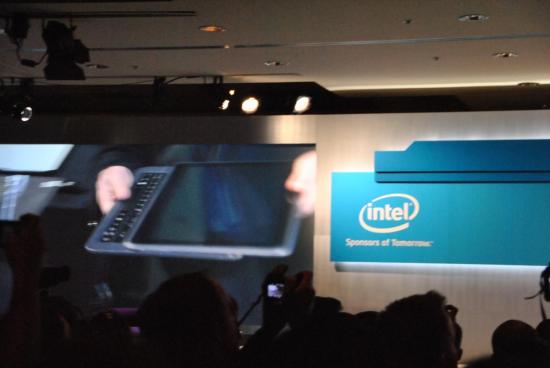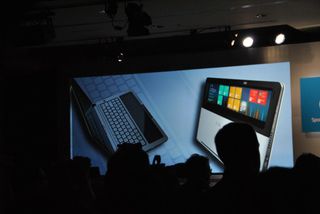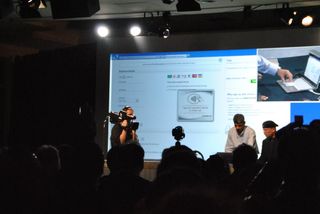Intel demos tablet-ish Windows 8 ultrabooks at CES 2012

Intel's press conference at CES 2012 looked exclusively at ultrabooks running Windows 8. That might be a bit of a let-down for those of us primarily interested in smartphones, but we're starting to see how the super-slim, super-light computers will collide with the tablet world.
The announcement of Windows 8 already painted a picture in that direction, but the hardware shown today displays even more overlap with tablets.
For one, there's touch control. Intel unveiled a number of ultrabooks which would make use of a touchscreen without requiring it as a primary input, as on a tablet. PCs have been trying this for awhile, and laptops too in the pre-iPad tablet days, both without particularly great results. What might make ultrabooks more successful is their slim size and hardware layout. One ultrabook Intel showed off had a fully reversible display, so you could carry it around as a tablet, or plop it on a desk and use it as a standard laptop. We've already seen some of the current breed of tablets, like the Transformer Prime, reach for the laptop world with its signature keyboard docking station, but it may hit a brick wall with full-fledge, equally-portable alternatives like these available. Another ultrabook had a slide mechanism to show and hide the keyboard, which we've seen in smartphones, but not yet in tablets.

Another model had a transparent touchscreen just below the keyboard through which you could see Windows 8 notifications without having to open up the device. You could also interact with those notifications in order to flip through stuff like upcoming calendar items, plus when it's open, there's palm detection so your cursor doesn't go bouncing all over the place while you're typing.
Beyond touch, Intel also showcased some very interesting movement control. One is the gyro style we're used to seeing in tablets and smartphones; in one demo, they tilted the ultrabook to navigate a 3D paper airplane on screen. It looked a little goofy holding an open laptop in that way, but it's easy to see that same interaction fit more naturally in a Windows 8 tablet. Another form of motion control demoed by Intel at CES 2012 was a simple Kinect-style interface. It used the front-facing camera to tell when you were making a throwing motion at it to play a simple game. I already feel like a bit of a dumbass playing Kinect in my living room, but it's really naturally for navigating menus, and could be a great way of avoiding smudges on touchscreens.

The most smartphoney thing of Intel's whole press conference was the inclusion of NFC in one of the ultrabooks on display. By tapping a Mastercard just below the keyboard of one laptop, you'll be able to securely complete an online transaction, and thanks to a locked-in pairing between card and device, you won't have to worry about foul play.
Although saying all that makes it sound like the current breed of 10-inch tablets may have a lot of competition to contend with, the vast majority of Intel's projected ultrabook production will be 11 inches and up. There's still plenty of overlap as far as use cases go (it's hard to imagine someone actively using both a 10-inch Android tablet and a 12-inch ultrabook), and I personally am holding out on fully investing in tablets until they can run Windows like a big boy, but tablets borne out of smartphone software will likely still have a home for the foreseeable future. What do you guys think: will Windows 8 tablets put the likes of the iPad and oodles of Android tablets to test? As the line between mobile tablet and full-fledged PC starts blurring, should we be covering Windows 8 tablets here on WPCentral?
Get the Windows Central Newsletter
All the latest news, reviews, and guides for Windows and Xbox diehards.
You can get a closer look at Intel's ultrabook news over here.
